Sea beet – Identification, Distribution, Edibility, Sustainable Harvesting, Recipes
Beta vulgaris marítima
- Edibility – 4/5 – Leaves have a rich, succulent and deeply satisfying flavour, akin to its relations spinach and chard, only with more flavour, greater succulence and a salty tang. Leaves of all sizes are excellent, though you may wish to remove the thicker midrib of larger leaves if you intend to cook and use it like spinach – easily done by folding them in half along their length and tearing out the midrib. In mid to late spring leaves develop an unpleasant bitter backnote which lasts throughout the summer. Roots, flowers and thick flowering stems are not worthwhile eating.
- Identification – 4/5 – Large diamond to oval shaped glossy leaves, 4 – 20 cm long, developing initially in rosettes then later “stacks” up to 80cm tall above the high tide line. There isn’t much to worry about that it can be confused with in its habitat. It is related to equally delicious orache, but is much more substantial, with glossier, less angular leaves. Sea beet flower heads are not showy, borne on a thick, fleshy grooved stem in a leafy spike. Individual flowers are hermaphroditic (self-pollinating by wind), green and tiny with the sepals thickening and hardening around the fruits.
- Distribution – 3/5 – Common in its habitat around much of the UK, but largely absent around Scotland’s West, North and North-East coast.
- Season – All year, but best when not flowering (flowers May – August) when leaves become bitter, and can be a bit below par in January/February in its more northerly locations
- Habitat – Upper beach above the high tide line, coastal defences and waste ground adjacent to coast. Occasionally cliffs. Somewhat counter-intuitively, sea beet often seems to do better in more exposed locations – my best spot for it in SW Scotland faces the full brunt of atlantic gales, while more sheltered locations have little or none.
- Sustainable Harvesting – Careful cropping of a few leaves per plant, leaving flowering stems intact, and rotating areas from which you harvest, and still further restraint during winter, should allow for a steady supply year on year.
- Safety Note: Sea beet is on the whole exceedingly good for you, but the leaves are relatively high in oxolates. These are not problematic when ingested in moderation as part of a balanced diet by healthy people, but if you have been warned by your doctor against spinach or rhubarb, the same warnings apply here.
Sea beet is an aristocrat in the world of wild greens. Like many true aristocrats, it has an unkempt appearance that belies its pedigree. Look for glossy, oval to diamond shaped leaves in unruly rosettes on the foreshore and in about sea defences. Its genes have been tamed and refined down the ages to give us many varieties of beetroot, sugar beet, chard, spinach and lots more, so it should seem familiar. You can occasionally see the purple colouration from which beetroot was selectively bred in the young leaves.
Variety is great, but I don’t think we have ever improved on the original. You can really taste sea beet’s pedigree if you boil, blanch, steam, wilt or eat raw the succulent leaves. They have superior flavour, texture and nutrient content to any of their progeny. If you like spinach, you will absolutely love sea beet.
Leaves are at their best in spring, with a bitterness developing in late spring and through the summer months as it flowers and sets seed. The bitterness fades in the autumn, leaving a reduced, but still steady supply of leaves.
I enjoy it in soups, tarts, salads, with fish and lamb. It makes for a very good saag aloo.
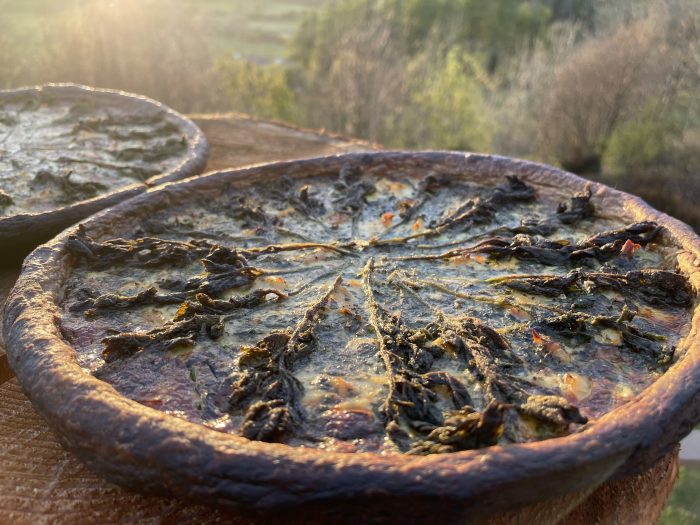
Sea beet, smoked haddock and common hogweed tart – served as part of a wild food picnic on my coastal foraging events.
Sea beet is a fairly common plant, with glossy green colonies locally abundant in some areas. That said, I would urge you to leave solo specimens alone, and spread your picking around well established plants where they proliferate.
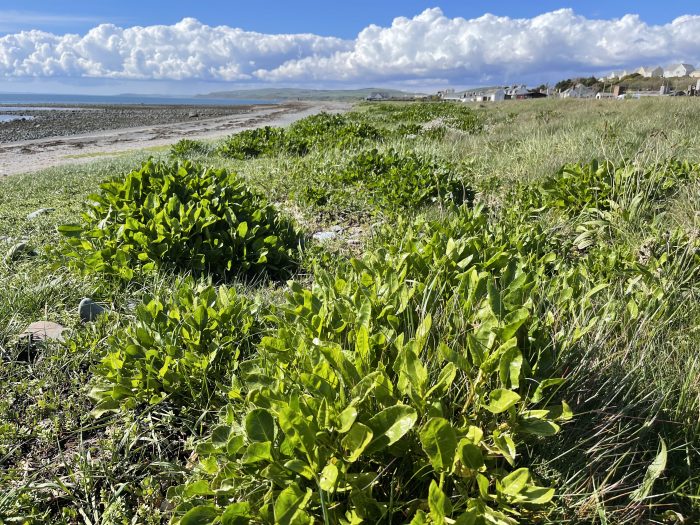
Where established, sea beet can provide vast, nourishing wild foods resources. ©GallowayWildFoods.com
I absolutely love the contradictory nature of these plants which manage to be unruly in their growth, while exhibiting pristine, glossy leaves which actually squeak as you pick them. It also often grows in spectacular locations with waves breaking at it and spindrift tumbling across its stalwort glossy greens. Magnificent!
Sea beet’s incredible, rich, green goodness, squeaky leaves & stacked glory, defy the challenges of its exposed home. Its one of many reasons I could never live far from the sea. This is the sort of stuff that would have nourished our hunter-gatherer ancestors, though it is seldom discussed as it doesn’t show up in the fossil record like bones and shell middens. But foragers *know* when they connect with it, and feel that lineage as it nourishes them.
In mid May, just as sea beet is reaching its full, glossy magnificence, with leaves the size of my hands, I make a big harvest then blanche in batches, refreshing in iced water to help retain their colour, before wringing out thoroughly and freezing in portion sized lumps for leaner months ahead.
One particular colony of sea beet has generously nourished my family and I for the last 14 years. After a huge storm 8 years ago many of its roots were smashed and hurled over a wide area. I mourned and picked through the debris, replanting and nurturing the injured. But I should have known better, and trusted in the resilience and wisdom of plants that are fully adapted to their generous but sometimes hostile home…
Within 2 years the colony was back in rude health – renewed & invigorated- and tastier than ever!
I now thank and nurture this colony by removing washed up plastic as I forage.
Despite the apparent pristine nature of its glossy leaves, I always thoroughly wash sea beet as they are perfect targets for dog and fox pee. They no doubt quietly appreciate the extra fertiliser, on top of their already rich bed of dead seaweed. 🙂
Much more common than sea beet (at least in SW Scotland) is its near relation in the goosefoot (chenopodium) family, orache, which is less substantial but equally delicious before it flowers.
Curiously, these generously green shrubs are also in the same family as the rather different looking , but equally delectable, marsh samphire.
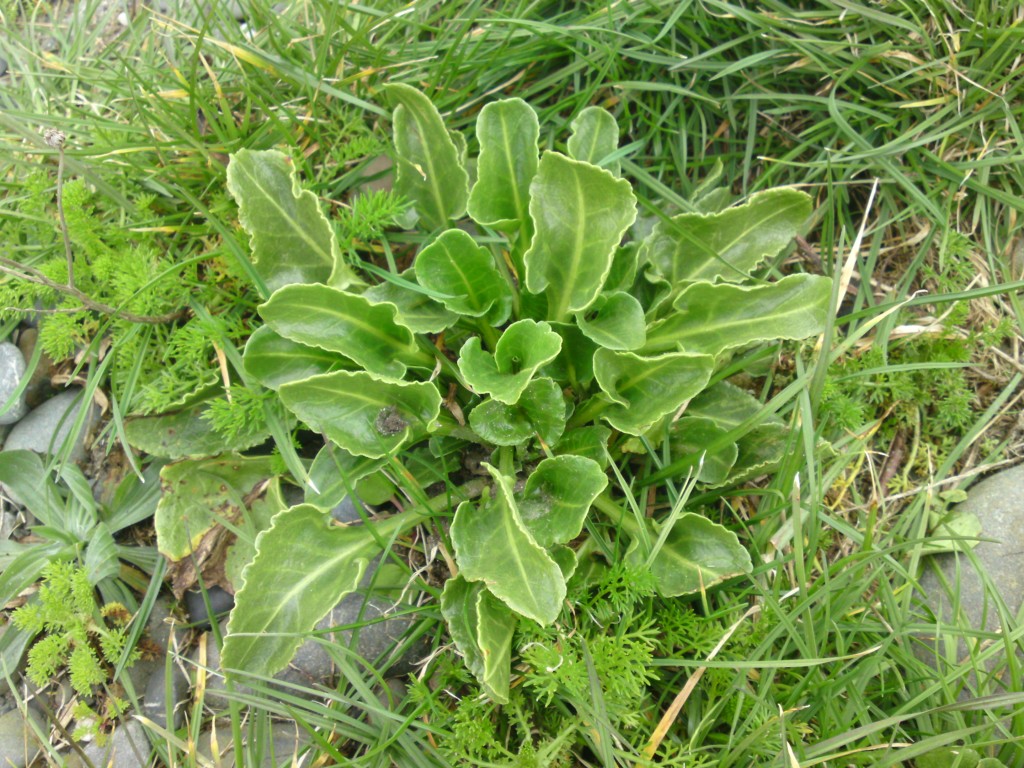
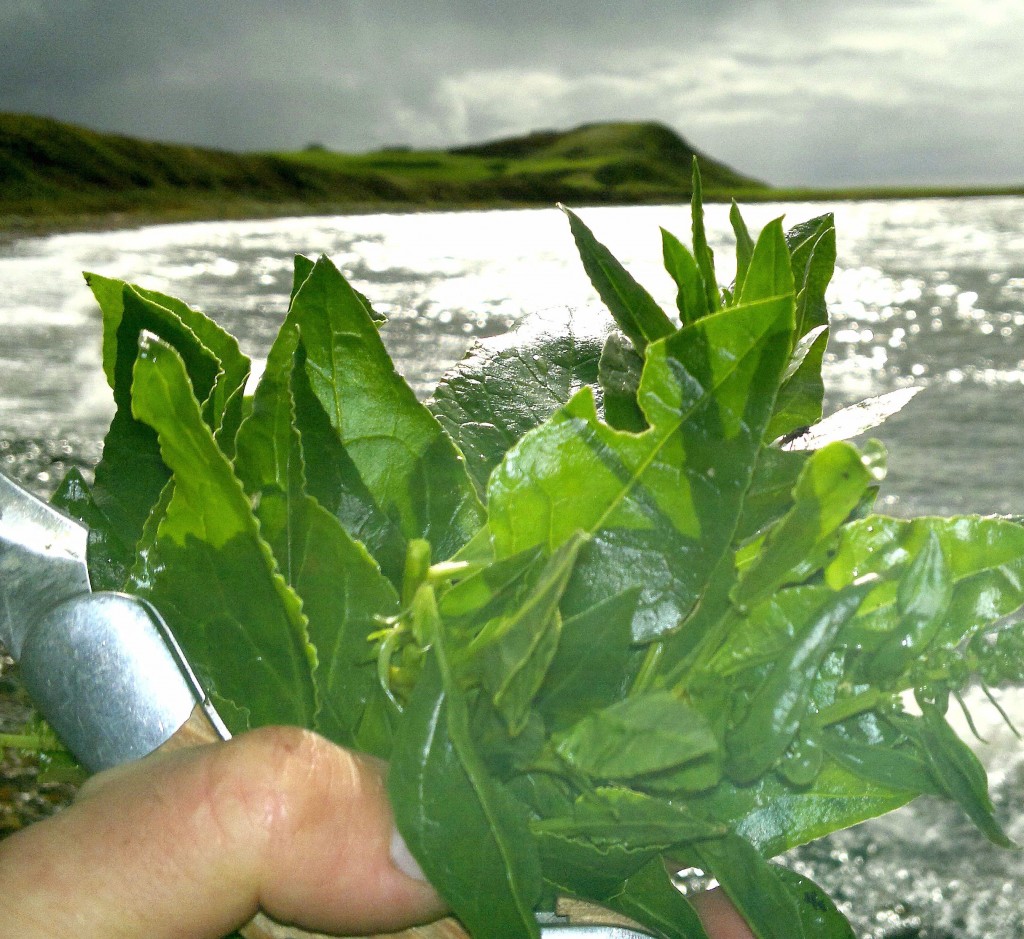
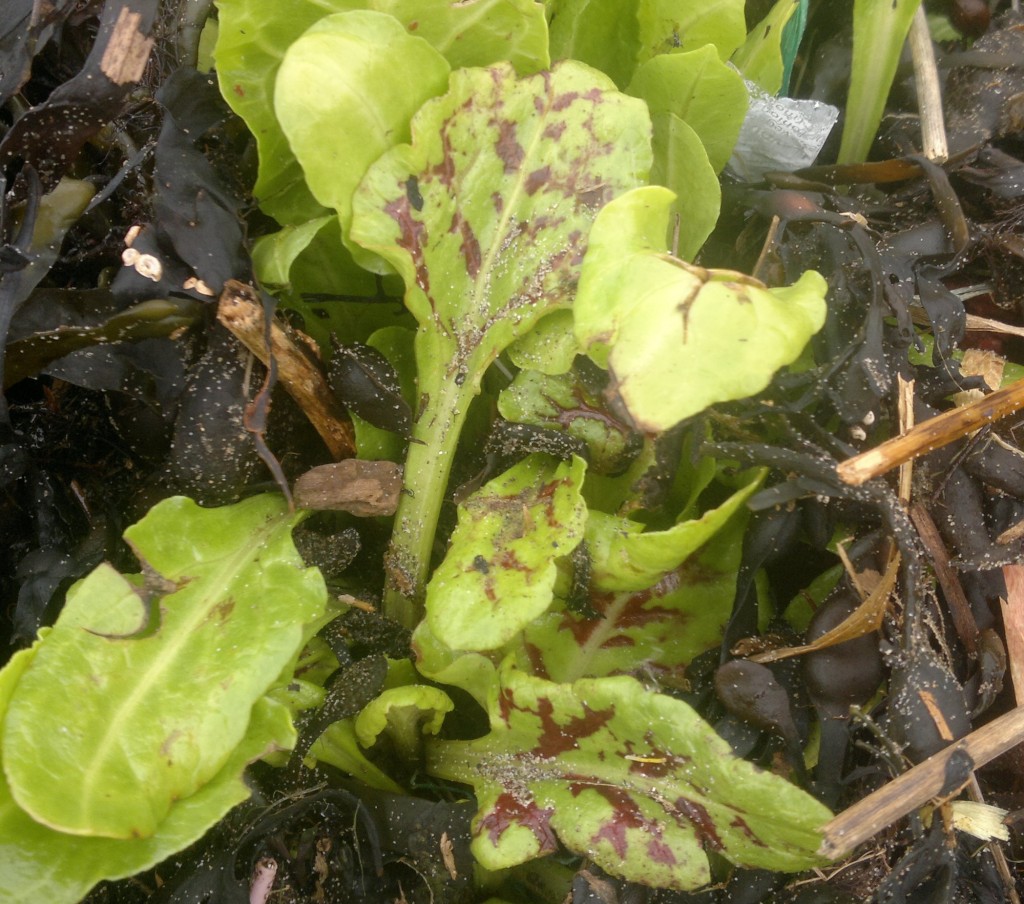
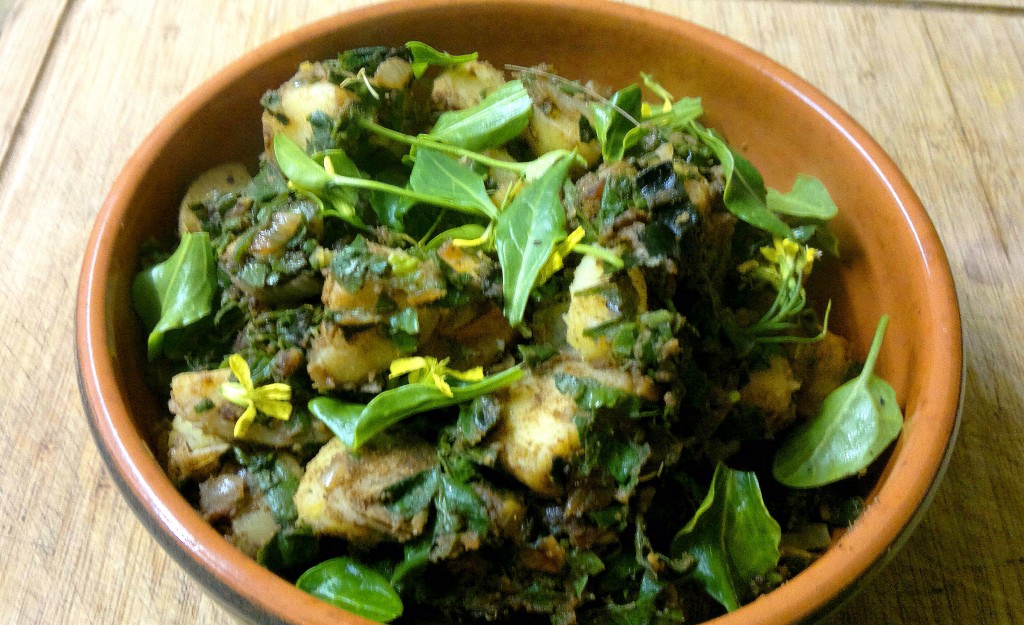
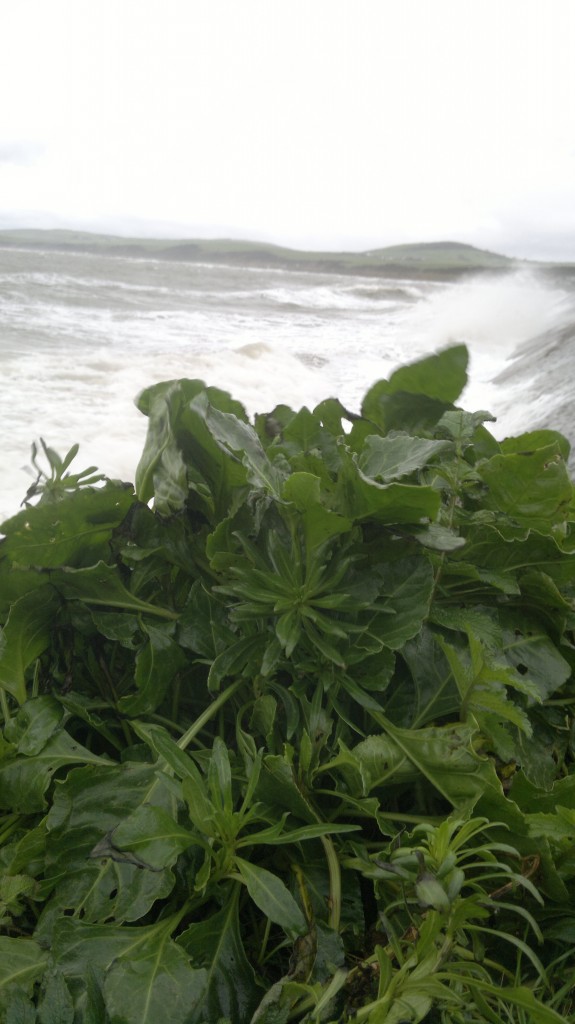
13 Comments
Hi Retired botany professor. Taught some economic botany. Mentioned modern derivative varieties from Sea Beet = Beta vulgaris (lower case ‘v’ is proper, please.) Is seed available? I’d like to grow some, if I could. Possibly potted so I can bring them in for the winter. Can be -30C some nights.
Hi, Busy foraging teacher.
Good manners is proper, please.
As a botany professor, is it not possible for you to gather some seed yourself?
I don’t supply and i’m not a gardener.
Regards,
Mark.
I’m in British Columbia. I notice that I can obtain several varieties (cultivars?) of “leaf beet” seed but the original is of greater interest. Has anyone attempted to cultivate the original inland? Are these plants perennials?
We have it growing in abundance in our garden in Manchester, after simply grabbing some when we saw it by the sea, and potting it up when we got home! 😀 I highly recommend it. [It needs to be put in the ground – doesn’t grow in a pot!] My all time favourite perennial veggie!
Cathy, How did you manage this? I tried but wasn’t successful. Could be the weather was too hot and as I ent away for a few days it didn’t get enough water
In the wild there are many clearly different varieties all within the same species and living next to each other. Some have big fat leaves and grow tall, others are short and squat, some short with big fat leaves.
Some have such a profusion of seeds I wonder why it’s never cultivated for its seeds alone. They are distant relatives of quinoa. Maybe a selective breeding program could develop that trait, just like selective breeding created beetroot.
We have a few plants in our garden. They’re perennial, with a substantial tap root to store starch overwinter, which was selectively bred into sugar beet, and beetroot.
Here in South East England the seeds a available around August. I’ll see you some if you want.
Thanks Brian. I guess like most plants, a combination of environmental challenges, phenotypes and genetic mutation lead to a wide range of physical forms. Yes, it is my understanding too that these are the ancestors from which many of our modern cultivars were bred. I use the seeds of that other goosefoot – orache – like quinoa. Very kind of you to offer seeds, but I have some good, healthy colonies nearby, and occasionally rescue storm-tossed roots which take quite well in the garden – hardy stuff! 🙂
I was walking by the sea today and seen a lady picking it. I asked her about it, and she said it was wild spinagh. Tasted it, and it was lovely. I looked up your site when I got home and found it very interesting. Will definately be picking more of this.
Margaret
Does anyone have any good recipes for Sea Beet roots know how to treat them?
I tried roasting them in chip style with skin on, oil, salt and rosemary…..the texture was pretty chewy.
Thanks,
Aidan
No, sorry. They are almost invariably woody in my experience. I only try them when they get smashed up by a storm, so maybe not the fairest trial. But I prefer to leave them to create more amazing salad! 🙂
It’s like eating the bark off your favourite Apple tree. DON’T
I live in Spain and there are so many Sea Beet Plants where I live,love it, better than Spinage, I don’t want to post it in Facebook because I don’t want everyone picking at the Plants..
Hello can you give some advice on how/when to harvest and sow seeds? I just found a single sea beet plant on an otherwise barren seaside walk near my house and I’d like to encourage more of them to grow!